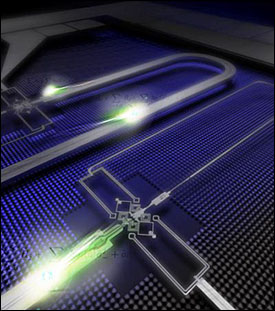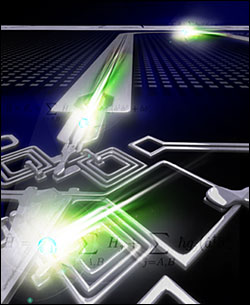
All Aboard the Quantum 'Bus'
NEW HAVEN, Conn., and GAITHERSBURG, Md., Sept. 27, 2007 -- Two research groups have independently demonstrated a superconducting quantum 'bus,' using it both to store and transfer information between independent quantum bits (qubits) and as a way to enable the interaction of two qubits, creating a combined superposition state. The work could lead to the creation of ultrafast quantum computers.
If they can be built, quantum computers -- harnessing the unusual rules of quantum mechanics, the principles governing nature’s smallest particles -- might be used for applications such as fast and efficient code breaking, optimizing complex systems such as airline schedules, making counterfeit-proof money, and solving complex mathematical problems. Quantum information technology in general allows for custom-designed systems for fundamental tests of quantum physics and as-yet-unknown applications.
A team at Yale University in New Haven led by professors Robert Schoelkopf and Steven Girvin said it is now sending a photon signal on demand from a quantum bit, or qubit, onto wires and transmitting the signal to a second, distant qubit. Over the past several years, the team has explored the use of solid-state devices resembling microchips as the basic building blocks in the design of a quantum computer. Now, for the first time, they have used superconducting qubits, or artificial atoms, to communicate information not only to their nearest neighbor, but also to a distant qubit on the chip.

Artist's rendition of the National Institute of Standards and Technologies (NIST) superconducting quantum computing cable. (Illustrations by Michael Kemper)
Their work, along with that of a group at the National Institute of Standards and Technologies (NIST) in Gaithersburg, is the cover story of the Sept. 27 issue of the journal Nature. The Yale group also had a paper on related research appear in the Sept. 20 Nature.
The Yale researchers said their work moves quantum computing from “having information” to “communicating information.” In the past, information had only been transferred directly from qubit to qubit in a superconducting system, but Schoelkopf and Girvin’s team engineered a superconducting communication bus to store and transfer information between distant qubits on a chip. This work, according to Schoelkopf, is the first step to making the fundamentals of quantum computing useful.
Their first paper documented the ability to produce on demand -- and control -- single, discrete microwave photons as the carriers of encoded quantum information. While microwave energy is used in cell phones and ovens, their sources do not produce just one photon. This new system creates a certainty of producing individual photons.
“It is not very difficult to generate signals with one photon on average, but, it is quite difficult to generate exactly one photon each time. To encode quantum information on photons, you want there to be exactly one,” according to postdoctoral associates Andrew Houck and David Schuster, who are lead co-authors on the first paper.
“We are reporting the first such source for producing discrete microwave photons, and the first source to generate and guide photons entirely within an electrical circuit,” said Schoelkopf.
In order to successfully perform these experiments, the researchers had to control electrical signals corresponding to one single photon. In comparison, a cell phone emits about 1023 photons per second. Further, the extremely low energy of microwave photons mandates the use of highly sensitive detectors and experiment temperatures just above absolute zero.
“In this work we demonstrate only the first half of quantum communication on a chip -- quantum information efficiently transferred from a stationary quantum bit to a photon or ‘flying qubit,’” said Schoelkopf. “However, for on-chip quantum communication to become a reality, we need to be able to transfer information from the photon back to a qubit.”
This is what they reported in the second paper. Postdoctoral associate Johannes Majer and graduate student Jerry Chow, lead co-authors, added a second qubit and used the photon to transfer a quantum state from one qubit to another. This was possible because the microwave photon could be guided on wires -- similarly to the way fiber optics can guide visible light -- and carried directly to the target qubit. “A novel feature of this experiment is that the photon used is only virtual,” said Majer and Chow, “winking into existence for only the briefest instant before disappearing.”
To allow the crucial communication between the many elements of a conventional computer, engineers wire them all together to form a data “bus,” which is a key element of any computing system. Together the new Yale research constitutes the first demonstration of a “quantum bus” for a solid-state electronic system. This approach can in principle be extended to multiple qubits, and to connecting the parts of a future, more complex quantum computer.
Physicists at the National Institute of Standards and Technology (NIST) report in their Nature article that they have transferred information between two qubits by way of electronic vibrations on a microfabricated aluminum cable. The setup resembles a miniature version of a cable television transmission line, but with some powerful added features, including superconducting circuits with zero electrical resistance, and multitasking data bits that obey the unusual rules of quantum physics.
A superconducting qubit is about the width of a human hair. NIST researchers fabricate two qubits on a sapphire microchip, which sits in a shielded box about 8 cubic millimeters in size. The resonant section of cable is 7 mm long, similar to the coaxial wiring used in cable television but much thinner and flatter, zig-zagging around the 1.1 mm space between the two qubits. Like a guitar string, the resonant cable can be stimulated so that it hums or “resonates” at a particular tone or frequency in the microwave range. Quantum information is stored as energy in the form of microwave particles or photons.
The resonant cable might someday be used in quantum computers, which would rely on quantum behavior to carry out certain functions, such as database searches, exponentially faster than today’s most powerful computers. Moreover, the superconducting components in the NIST demonstration offer the possibility of being easier to manufacture and scale up to a practical size than many competing candidates, such as individual atoms, for storing and transporting data in quantum computers, the physicists said.

Artist's extreme zoom view illustration of the NIST coplanar waveguide cavity connecting two superconducting phase quantum bits, or qubits, at each end.
Unlike traditional electronic devices, which store information in the form of digital bits that each possess a value of either 0 or 1, each superconducting circuit acts as qubit which can hold values of 0 and 1 at the same time. Qubits in this “superposition” of both values may allow many more calculations to be performed simultaneously than is possible with traditional digital bits, offering the possibility of faster and more powerful computing devices. The resonant section of cable shuttling the information between the two superconducting circuits is a “quantum bus” and could transport data between two or more qubits.
As explained in the Nature article, the scientists encoded information in one qubit, transferred this information as microwave energy to the resonant section of cable for a short storage time of 10 nanoseconds, and then successfully shuttled the information to a second qubit.
“We tested a new element for quantum information systems,” said NIST physicist Ray Simmonds. “It’s really significant because it means we can couple more qubits together and transfer information between them easily using one simple element.”
In addition to storing and transferring information, NIST’s resonant cable also offers a means of “refreshing” superconducting qubits, which normally can maintain the same delicate quantum state for only half a microsecond. Disturbances such as electric or magnetic noise in the circuit can rapidly destroy a qubit’s superposition state. With design improvements, the NIST technology might be used to repeatedly refresh the data and extend qubit lifetime more than one hundred times, sufficient to create a viable short-term quantum computer memory, Simmonds said.
NIST’s resonant cable might also be used to transfer quantum information between matter and light -- microwave energy is a low-frequency form of light -- and thus link quantum computers to ultrasecure quantum communications systems.
The NIST research was supported in part by the Disruptive Technology Office. Funding for Schoelkopf and Girvin's team was provided by the National Security Agency under the Army Research Office, the National Science Foundation and Yale University.
For more information, visit: www.yale.edu or www.nist.gov
Published: September 2007